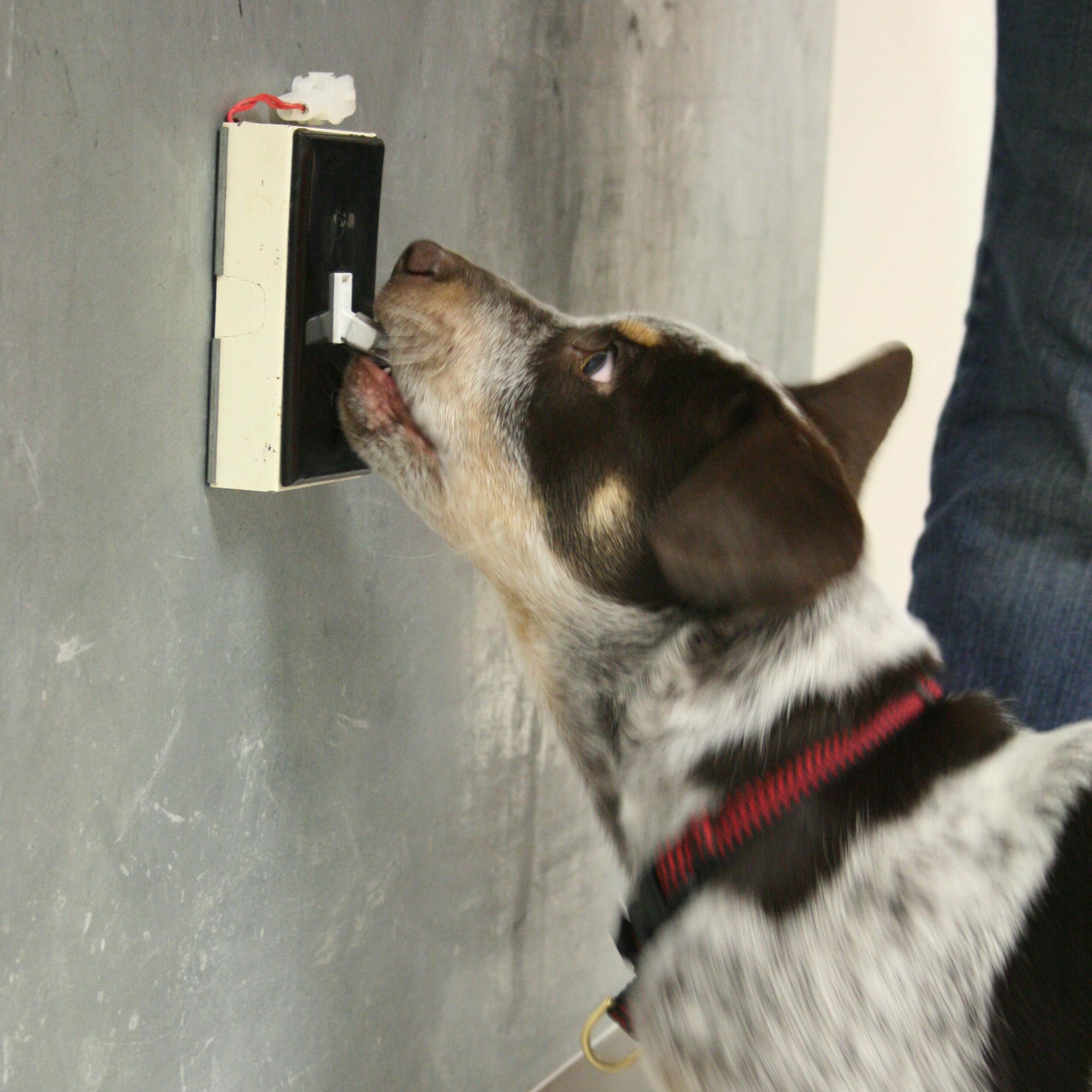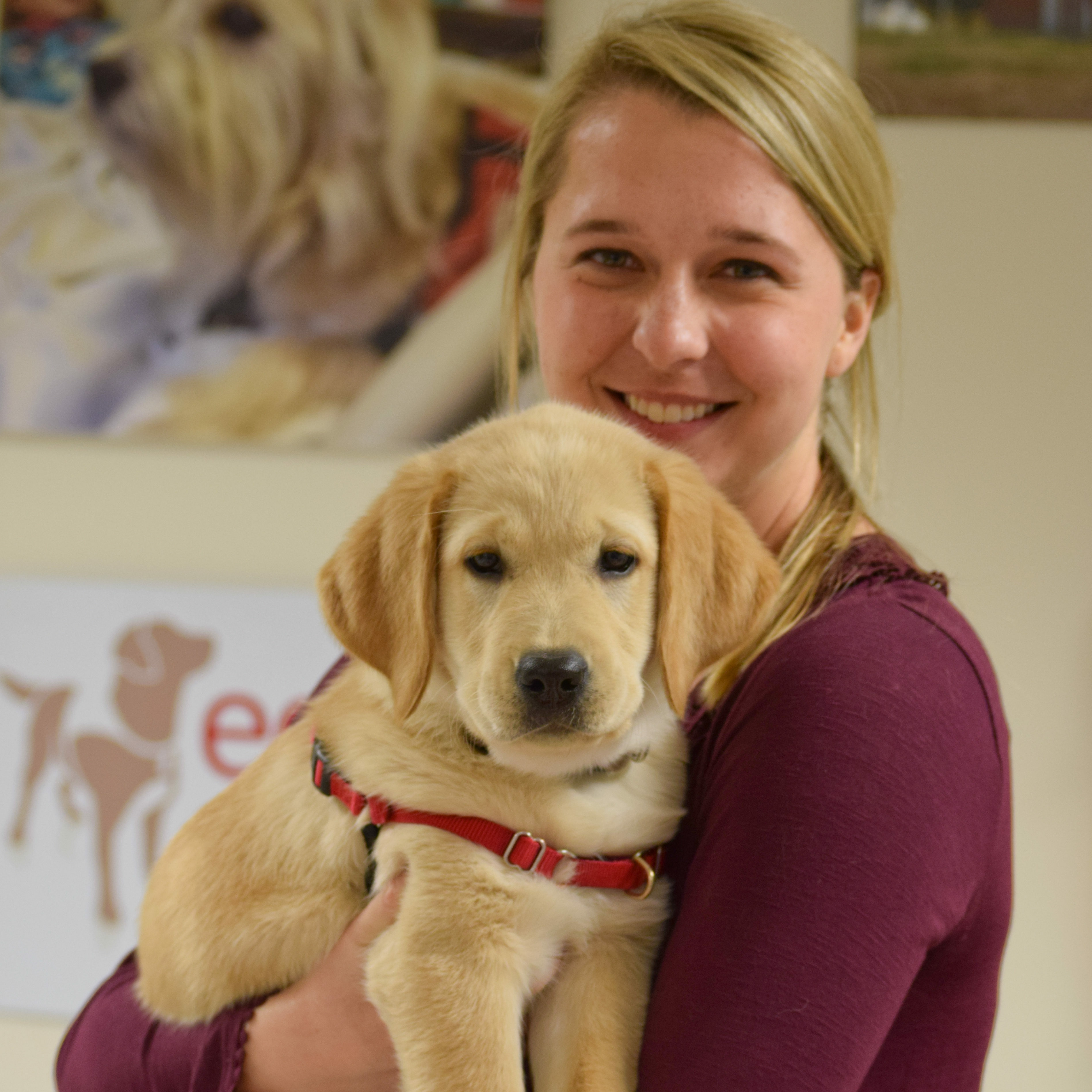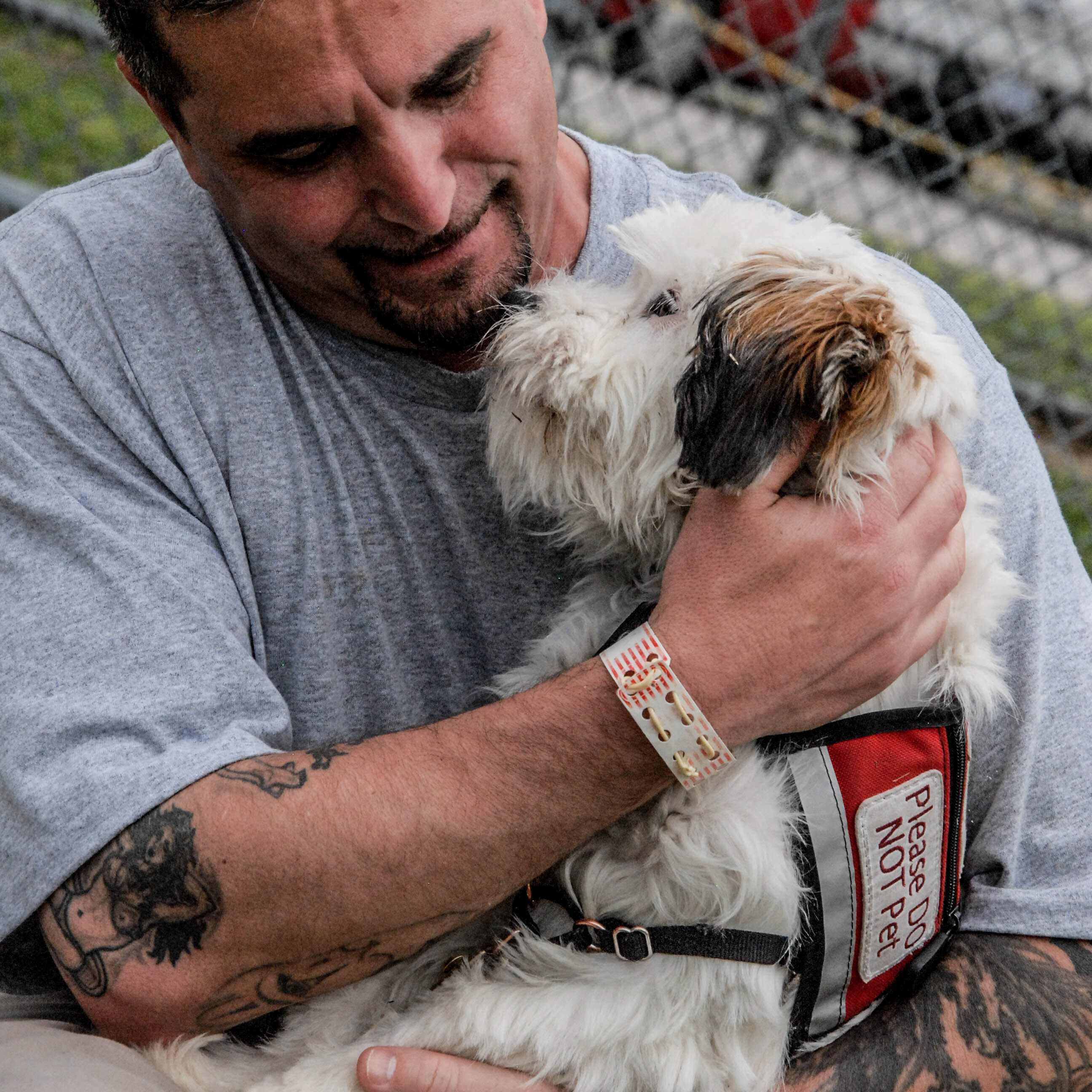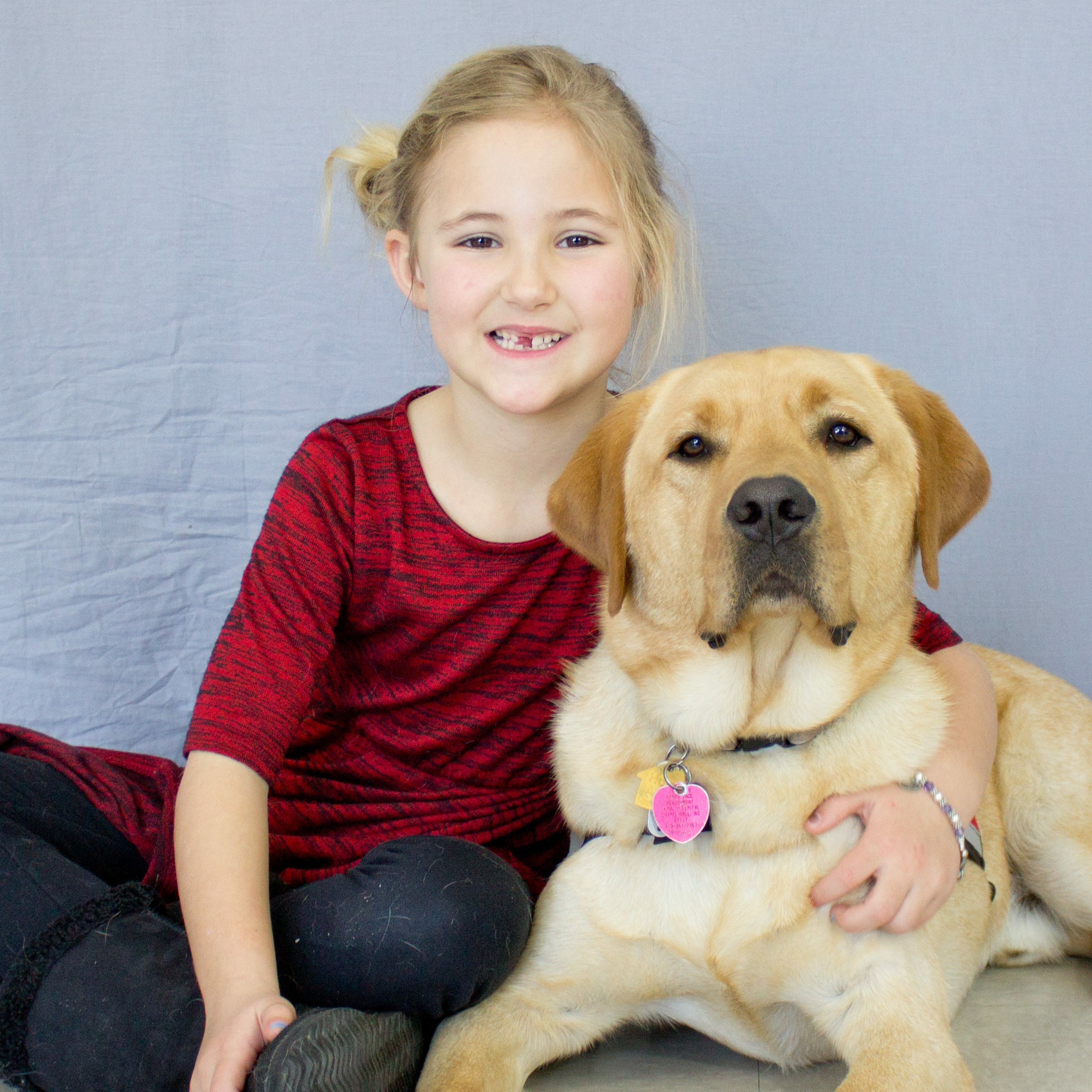FOLLOW A PUP
EENP partners people with dogs to improve lives, and our pups transform lives from the day they enter training until the day they retire, up to a decade later.
Click on each step below to follow a pup’s journey as it moves through training with EENP…
Pup Selection
Teamwork is a part of our pups’ lives even before they are born! Most of our pups were purpose-bred for assistance work through a cooperative effort of assistance dog schools.
Virtually all of the pups that enter training with EENP are purpose-bred for a career of service. Many of these extraordinary pups are part of the Assistance Dogs International Breeding Cooperative (ABC), an innovative collaborative effort of assistance dog organizations that have pooled our breeding resources to produce the highest-quality assistance dogs possible.
EENP also breeds its own dogs and works with carefully screened private breeders. From time to time, we are able to bring rescue dogs into training as well.
The majority of our dogs are Labrador Retrievers, Golden Retrievers, or a Lab-Golden cross.

Training Techniques
Positive training techniques mean both our dogs and trainers are excited about learning and working. Our dogs have a toolbox of skills that can be adapted to their partners’ needs - even as those needs change over the years.
EENP dogs learn a lot of commands – but more importantly, they learn to love learning. We use positive training techniques so our dogs – and trainers – are excited about learning and working!
Our dogs are flexible learners who have a toolbox of skills that can be adapted to their partners’ needs, even as those needs change over the years of their partnership.
EENP dogs learn to use their bodies in a variety of ways that become building blocks for complex skills, so a nose push becomes the basis for a variety of behaviors, from alerting with a nose bump to activating a crosswalk button with the nose. This makes the initial training for all of our dogs remarkably similar, whether they are destined to become Mobility Service Dogs or Medical Alert Dogs, and regardless of the client they will be matched with.
On top of this training, Medical Alert Dogs are also trained to detect one or more target scents, such as diabetic blood sugar highs or lows. The training begins with simple exposure to the scent and encouragement when the dog pays attention to the scent. The training progresses through a series of steps where the dogs learn to link the smell with an alerting behavior, typically a nose bump, as well as other behaviors such as going to get help.
All of our service dogs are extensively socialized and trained to accompany their handlers in public so they are prepared to assist at any time they are needed. This includes training on various forms of transportation, including buses and airplanes.
Our pups’ training starts in the loving hands of our Young Puppy Trainers…

Young Puppy
Young puppies touch the hearts of everyone they meet! Young Puppy Trainers form a loving community that gives our pups the best possible start on their journey of service.
When pups leave their litters and come into training at EENP, they start in community homes. These community volunteers are called Young Puppy Trainers and they are some of our most important volunteers.
A Young Puppy Trainer lives with, loves, and trains an EENP pup for 4-7 months until the pup is ready to move into training in prison. Trainer and pup participate in weekly group training classes at EENP, and the Young Puppy Trainer is responsible for house-breaking the puppy and providing basic socialization and training.
Young Puppy Trainers are very active volunteers who often bring their pups to PR events and help spread the word about EENP.
Young puppies come into EENP three days a week for “day care” to get foundation training from EENP staff.
When pups are 5-8 months old, they move into prison and start training in our prison training partnership, At Both Ends of the Leash (ABEL)…

ABEL
Our pups spend 12-18 months training in prison, where they learn the skills to assist our clients – and along the way, allow their inmate-trainers to transform their self-image from “I hurt people” to “I help people”.
Our assistance dogs enter training in our prison partnership, At Both Ends of the Leash (ABEL), when they are about six months old. The ABEL program is focused on producing skilled assistance dogs that will improve the lives of EENP clients and, by design, ABEL gives the inmate-trainers the opportunity to improve their own lives as well.
ABEL trainers say they are in prison because they were focused on helping themselves at the expense of others. ABEL gives them a chance to help someone else in a profound way.
The impact of that work is reinforced by periodic ceremonies at which trainers have an opportunity to meet the EENP clients whose lives they are changing.
Further, the dedicated support of EENP staff, volunteers, and donors demonstrates to the trainers that people care about them, are invested in their success, and value them for the good they are accomplishing now rather than judging them for the mistakes they made in the past. That opens a space for ABEL trainers to feel worthy of that investment and helps them transform their self-perception from “I hurt people” to “I help people.”
EENP pups are in training at ABEL for 12-18 months, but they aren’t in prison all of the time…

Furlough
There are some experiences that can’t be had in prison, so pups rotate out of ABEL periodically. Teamwork bridges prison walls when furlough trainers extend the ABEL trainers' work with the pups into the community.
Each dog in the ABEL program rotates out of prison on “furlough” for a week each month to live with a furlough trainer. Furlough trainers always have a dog, but a different dog each week.
Furlough trainers are either EENP staff or advanced volunteers who can make a long-term commitment to furlough training.
While a dog is out on furlough, the furlough trainer is focused on getting the dog training in settings that are unavailable in prison; checking the dog’s skills to give feedback to the ABEL trainer; and evaluating the dog for progress toward graduation.
During furlough, the pup comes into our office for advanced training and evaluation…

Work Release
Trainers who excel in the ABEL program may move on to our work release program where they become a vital and visible part of the EENP community. While prepping pups for graduation, work release trainers are prepping themselves for their return to the community.
Pups on furlough get extra training from our work release trainers. Inmate-trainers who excel in the ABEL program may be considered for employment with EENP through our work release trainer program once they are promoted to minimum security custody. Work release trainers are a critical part of our dogs’ training journey.
Work release trainers come in with a solid foundation of dog-training skills and provide an immediate and invaluable contribution to EENP’s operations. Perhaps more importantly, the inmate-trainers in the ABEL work release program expand and refine their professional skills and create positive relationships within the community, which helps them transition successfully into life after incarceration.
At EENP’s office, work release trainers juggle various responsibilities such as supporting existing client-canine partnerships, leading training classes for volunteers, speaking to the public about EENP and the ABEL program, and managing the overall training progression for all pups in the program. Work release trainers learn and refine skills as varied as their responsibilities – interpersonal communication, effective instruction, public presentation, and time/project management – skills that will help them be valuable employees in whatever career they pursue after prison.
Work release trainers work with dogs in the same settings our clients work in once paired with their service dogs – at the mall, in the grocery store, in the hospital, on the bus. Daily training excursions provide an opportunity for work release trainers to take the culture of praise and positive feedback from the prison dog training program and use it to reframe interactions with the public. With enhanced visibility in the community due to the constant presence of a pup-in-training at their side, these trainers interact with hundreds of strangers weekly – many of whom express their respect and admiration for the masterful manner in which the trainers support pups of all ages in training situations.
When pups are mature and have learned all the skills needed for their careers, they are ready for placement…

Partnership
At about 24 months of age, pups move on to their next career changing the lives of EENP clients. As assistance dogs, they integrate so fully into clients' lives that clients forget they have physical limitations.
An EENP dog starts a second career of changing lives once she finishes training in ABEL and is partnered with a client who has a disability.
EENP places two kinds of assistance dogs: mobility service dogs assist clients with a variety of tasks such as retrieving items and opening doors, while medical alert dogs use their phenomenal sense of smell to detect changes in medical conditions like diabetes.
Over the course of a partnership, an assistance dog can provide more than 50,000 hours of service for a client.
Although EENP dogs can literally save the lives of our clients, the life-changing nature of the partnership is really an everyday event. Through daily assistance to our clients with tasks like turning on a light switch, monitoring blood sugar levels, or bringing an insulin kit, the amazing value of the relationship comes to life: assistance dog partnerships offer our clients improved health and safety, increased independence, and more integration into their communities.
It takes 1.5 to 2 years to train an assistance dog, and only about half of the dogs who enter training meet the demanding standards to become assistance dogs.
An assistance dog can work for 8-10 years, but partnerships don’t last forever. At some point, our dogs are ready for a career change…


